OK, now that I see your code, I can try and help out a little. I have refactored your example a little bit to make it easier for me to understand, but feel free to adjust to your needs.
index.html
I don't know what the page looks like that you're working with, but it looks like in your example you are creating an anchor element with JavaScript during the fetch() call. I'm just creating one with HTML in the actual page, is there a reason you can't do this?
<body>
<a id="downloadLink" download="excel.xlsx" href="#">Download Excel File</a>
<script type="text/javascript" src="/javascripts/test.js"></script>
</body
With that in hand, here is my version of your front end JS file:
test.js
const downloadLink = document.getElementById('downloadLink');
sendFetch('a', 'b', 'c');
function sendFetch(param1, param2, param3) {
const path = 'http://localhost:3000/excelTest';
const url = `${path}?parmA=${param1}&parmB=${param2}&parmC=${param3}`;
const serviceDetails = {};
serviceDetails.method = "GET";
serviceDetails.mode = "cors";
serviceDetails.headers = {
"Content-Type": "application/json"
};
fetch(url, serviceDetails).then((res) => {
if (res.status != 200) {
return false;
}
res.blob().then((excelBlob) => {
const excelBlobURL = URL.createObjectURL(excelBlob);
downloadLink.href = excelBlobURL;
});
}).catch((error) => {
return false;
});
}
I had to fill in some details because I can't tell what is going on from your code. Here are the things I changed:
- Selected the DOM element instead of creating it:
Your version:
a = document.createElement('a'), file;
My version:
index.html
<a id="downloadLink" download="excel.xlsx" href="#">Download Excel File</a>
test.js
const downloadLink = document.getElementById('downloadLink');
This saves us the trouble of creating the element. Unless you need to do that for some reason, I wouldn't. I'm also not sure what that file is doing in your original.
- Name the function and change parm -> param for arguments list
Your version:
function(parm1,parm2,parm3){
My version:
function sendFetch(param1, param2, param3) {
I wasn't sure how you were actually calling your function, so I named it. Also, parm isn't clear. Param isn't great either, should describe what it is, but I don't know from your code.
- Create a
path variable and enclose url assignment in backticks
Your version:
let url =${path}?parmA=${parm1}&parmB=${parm2}&parmC=${parm3};
My version:
const path = 'http://localhost:3000/excelTest';
const url = `${path}?parmA=${param1}&parmB=${param2}&parmC=${param3}`;
In your version, that url assignment should throw an error. It looks like you want to use string interpolation, but you need backticks for that, which I added. Also, I had to define a path variable, because I didn't see one in your code.
- Cleaned up some formatting
I used 'dot' notation for the serviceDetails, but that was just personal preference. I also changed the spacing of the fetch() call, but no need to reprint that here. Shouldn't effect anything.
- Create a blob from the fetch response
Your version:
var file = new Blob([res], { type : 'application/octet-stream' });
My version:
res.blob().then((excelBlob) => {
I'm not sure why you are calling the Blob constructor and what that [res] is supposed to be. The Response object returned from fetch() has a blob() method that returns a promise that resolves to a Blob with whatever MIME-type the data was in. In an Excel documents case, this is application/vnd.openxmlformats-officedocument.spreadsheetml.sheet.
- Create an ObjectURL from the
Blob and add this URL to the href of the anchor tag.
Your version:
a = document.createElement('a'), file;
a.href = window.URL.createObjectURL(file);
a.target = "_blank";
a.download = "excel.xlsx";
document.body.appendChild(a);
a.click();
document.body.removeChild(a);
My version:
const excelBlobURL = URL.createObjectURL(excelBlob);
downloadLink.href = excelBlobURL;
You have to do a bunch of DOM manipulation, which I'm not sure why you need. If you do have to dynamically create this element, then I'm not sure why you are 'clicking' it, then removing it, if the user is supposed to be able to click it. Maybe clarify for me why you are doing this, or if you really need to do it. Either way, in my version I create the ObjectURL and then assign it, but you could just as easily not store it in a variable.
- Call the function that sends the fetch request.
As my function signature is:
function sendFetch(param1, param2, param3)
I needed to call it somewhere in order to fire off the request, so I did so like this:
sendFetch('a', 'b', 'c');
Right when the page loads, as you can see from the server logs:
GET / 304 0.448 ms - -
GET /javascripts/test.js 304 1.281 ms - -
GET /excelTest?parmA=a&parmB=b&parmC=c 304 0.783 ms - -
The first two requests are for the index.html page and the test.js file, then the fetch request is fired with the param's I passed in. I'm not sure how you are doing this in your app, because that is not included in your code.
Everything I just covered is Front-End. I'm assuming your server-side code is actually sending an excel file with your call to response.sendFile() in service.js. If you are sure that the file is getting sent, then the code I've given you should work, when adjusted to your app.
So, in conclusion, what this code does is:
- Load an HTML page with an anchor tag with no
href attribute set.
- Send off a
fetch() request to the server.
- Turn the fetch response into a
Blob, then create an ObjectURL from this Blob.
- Assign that
ObjectURL to the anchor tag's href attribute.
When the user clicks the 'Download Excel File' link, the Excel sheet should be downloaded. If you didn't want them to see the link until after the fetch request, you could definitely do create the anchor tag in JS instead, let me know if you want to see how to do that.
As before, here is a gif showing how it looks on my machine (this is with your version and my modifications):



